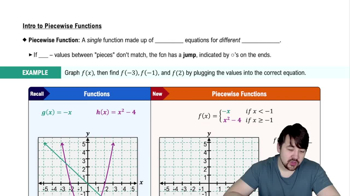Where is the function continuous? Differentiable? Use the graph of f in the figure to do the following. <IMAGE>
b. Find the values of x in (0, 3) at which f is not differentiable.
 Verified step by step guidance
Verified step by step guidance Verified video answer for a similar problem:
Verified video answer for a similar problem:



 5:02m
5:02mMaster Determining Differentiability Graphically with a bite sized video explanation from Patrick
Start learning